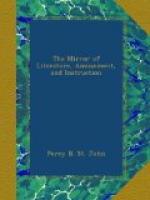The Earl of Lancaster, it will be remembered, became embroiled with Edward ii. and his minion Gaveston, who partly through the interference of Lancaster, was beheaded at Warwick after a siege in Scarborough Custle. The King swore vengeance for the death of his favourite, which led this weak sovereign into a long series of dissentions with the barons, at the head of whom, was the Earl of Lancaster. Both parties now flew to arms, but Lancaster soon found himself ill supported by his compeers, and marching northward for reinforcements from the celebrated Bruce, King of Scotland, the King in the meantime, sent the Earl of Surrey and Kent to besiege the castle of Pontefract, which surrendered at the first summons. Lancaster was next closely pursued by the king with great superiority of numbers. “The earl, endeavouring to rally his troops, was taken prisoner, with ninety-five barons and knights, and carried to the castle of Pontefract, where he was imprisoned in a tower which Leland says he had newly made towards the abbey,” This tower was square: its wall of great strength, being 10-1/2 feet thick; nor was there any other entrance into the interior than by a hole or trap-door in the floor of the turret: so that the prisoner must have been let down into this abode of darkness, from whence there could be no possible mode of escape; the room was twenty-five feet square. A few days after, the King being at Pontefract ordered him to be arraigned in the hall of the castle, before a small number of peers, among whom were the Spencers, his mortal enemies. The earl was condemned to be hanged, drawn, and quartered; but the punishment was changed to decapitation. After sentence was passed, he said, “Shall I die without answer?” He was not, however, permitted to speak; but a certain Gascoign took him away, and having put an old hood over his head, set him on a lean mare without a bridle. Being attended by a Dominican friar as his confessor, he was carried out of the town amidst the insults of the people; and there beheaded. Thus fell Thomas, Earl of Lancaster, the first Prince of the Blood, being uncle to Edward ii. who condemned him to death. Several of his adherents were hanged at Pontefract.




